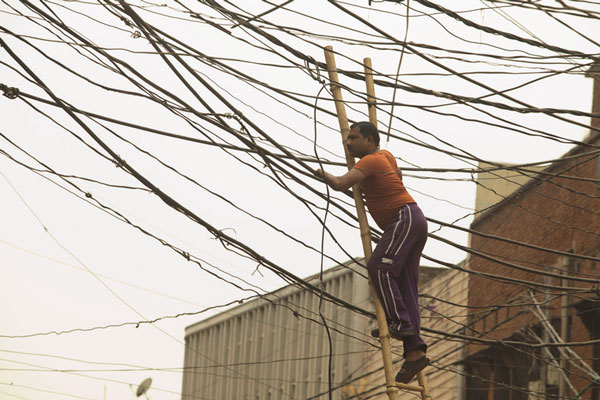
Power to the people: Loha Singh risks life and limb to supply the have-nots with electricity.
‘Robin Hood of electrical wiring’ sheds light on the rich/poor divide
 BY SAM SPOKONY | Those extended power outages that followed Hurricane Sandy gave us a small taste of the struggle faced every day by millions of people in developing countries. With that shock still fresh in our minds, “Powerless” will give English speakers everywhere an extraordinarily intense, yet well-balanced look at how an insufficient supply of electricity continues to devastate the impoverished Indian city of Kanpur — and it should force us in the West to acknowledge our own position of material privilege, while also confronting our preconceived notions about when it is or isn’t right to stop following the law.
BY SAM SPOKONY | Those extended power outages that followed Hurricane Sandy gave us a small taste of the struggle faced every day by millions of people in developing countries. With that shock still fresh in our minds, “Powerless” will give English speakers everywhere an extraordinarily intense, yet well-balanced look at how an insufficient supply of electricity continues to devastate the impoverished Indian city of Kanpur — and it should force us in the West to acknowledge our own position of material privilege, while also confronting our preconceived notions about when it is or isn’t right to stop following the law.
With around three million people living within its borders, Kanpur is about twice as populous as Manhattan — but well over 10 percent of its residents live without regular electricity. The film thus begins by following Loha Singh, a diminutive, crafty and mostly penniless character who’s known throughout the city as a kind of Robin Hood of electrical wiring. Whether it’s a household that needs to power a water pump for a family’s survival or a local factory that will be doomed if the machinery fails, Singh and others like him use katiyas (illegal, makeshift power lines that tap into the government supply grid) to divert the flow of electricity to those who either can’t afford to pay for it, or simply can’t access it. But, for all its benefits, we later learn that not everyone in town is proud of Singh or his line of work.
To capture the other half of the issue, the directors shift their focus to Ritu Maheshwari, the new managing director of KESCO (Kanpur’s equivalent of ConEd), as she attempts to crack down harder than ever on “katiyabaaz” like Singh. In board meetings, press conferences and extensive interviews, Maheshwari tries to explain that her perceived lack of mercy for the hundreds of thousands of “powerless” residents of Kanpur is part of her wish to create better conditions for everyone. If KESCO cuts off the thieves, it can actually make money via bill-paying consumers — and if it makes money, it can build new power generators to more effectively serve the city’s population.
But, to use a power pun, there’s just no stable connection between KESCO and the poor everyman of Kanpur. The two factions, who sit on opposite sides of socioeconomic privilege, can’t overcome the deep-seated resentment and the sheer lack of understanding that pervades this entire issue. The only sparks here are those that lead to explosions of anger — protests, insults and riots. Finally, we get glimpses of the politicians who say they’re going to make an impact on behalf of Kanpur’s struggling residents, as well as many others throughout India who live without electricity. But their words seem just as hollow as those we often hear in New York, when elected officials tell us they’re going to save us from the evils of the establishment.
This is a beautifully executed documentary that captures the tension of a thought-provoking issue without creating one-dimensional heroes or villains. The story of power in Kanpur, told in its honest entirety, will provide a truly valuable learning experience to Western audiences.

















